The bus in Vietnam has been part of not only the means of public transport but also national tourism. Whether it is to transfer to a local tourist site or to make a longer trip, the bus becomes nowadays more and more popular, and plays a role as a wonderful choice for people in modern life.
The idea of traveling by bus in Vietnam can be “intimidating”, it’s true, but a look at our article will give you all the information you need to reach your destination without a hitch on your tour to Vietnam!
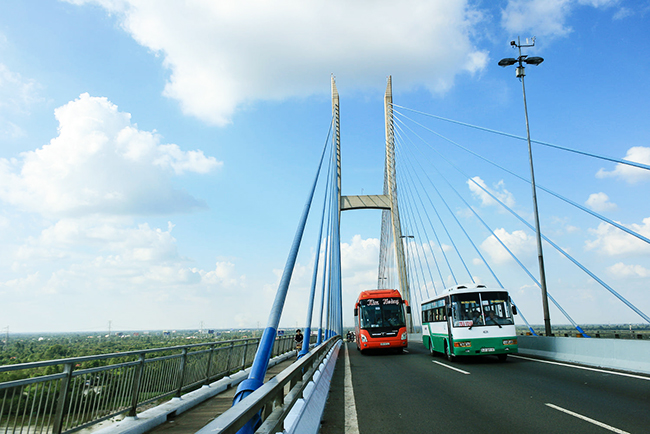
Bus tour in Vietnam – an interesting way of sightseeing the cities
Traveling by Bus in Vietnam, why not?
Indeed, if you want to explore Vietnam, you can make up your mind of various means of transport, for example, the plane, the train, or the bus.
It cannot be denied that the plane is the fastest means of transport. Despite that fact, it is still the most expensive transport, not to mention the fact that you will not be able to admire the magnificent landscapes of Vietnam to almost 35,000 feet of altitude!
As for the train, it crosses almost all of Vietnam and will allow you to admire magnificent beach side views. It is better to opt for this means of transportation when traveling from one big city to another and not to visit smaller rural areas.
So why traveling by bus in Vietnam?
If you have a thought that the bus is now real competition for the car, the train or the plane, here are some important advantages to traveling by bus:
- Price: Compared to the car, train or plane at this point, a bus is often an unbeatable option: cheap and economical.
- Comfort: Vietnam buses have been increasingly modern and international standards. The quality of the bus service is improving day by day to make sure you will get the most comfortable during the trip. The seats are comfortable and the catering service is often included in the ticket’s price.
- Safety: The bus is the safest means of transport with a lower accident rate than other means, thanks to stricter regulations and many safety standards.
- Contact: A bus is also a place for meetings, exchanges, and discussions. It allows people to interact and do activities with each other (when travelling as a couple or family), or promote meetings with strangers (when travelling as a group tour).
- The impact on the environment: Needless to say, the bus is the least harmful means of transport for nature. This is also the case if we focus on the carbon footprint.
Yet each means of transport has its charms and its little worries. The bus is no exception and there are inevitably disadvantages to take into account before choosing the bus to travel. Nonetheless, the main disadvantage of traveling by bus may be the very long duration of the trips. Besides, you should be attentive to the times of departure and arrival, which may be early or late, and present on time.
Types of Bus in Vietnam and Some Important Bus Routes
Travelling by bus in Vietnam is a very useful, cheap and easy way for any traveler. The dense bus network will allow you to reach the four corners of the country. If you’re stuck on the first steps such as finding a bus or the way to go, stay calm and read our article on the best way to travel by bus in Vietnam.
The bus system in Vietnam can be divided into 3 types: local bus, interprovincial bus and “open” bus.
1. Local Bus
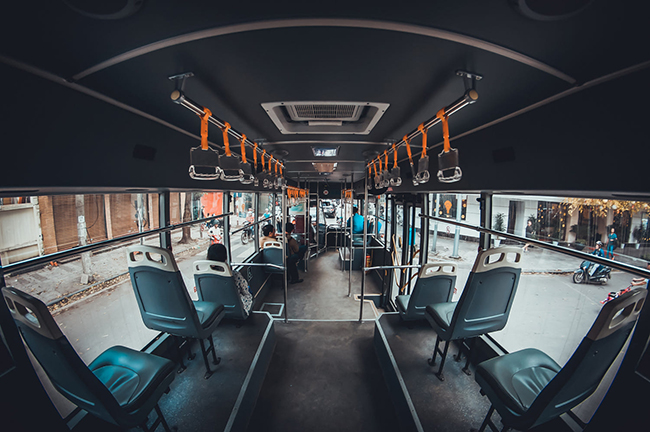
Inside a local bus in Vietnam
In Hanoi, Ho Chi Minh City or some major tourist destinations, there are many kinds of public bus service for both locals and foreign tourists. These buses also leave the main terminals before heading to other streets. In other provinces, we have buses run by private companies. Passengers can take a bus at the bus stops that are spreading across the province and buy tickets directly from the conductor. If you are traveling in the city center or want to reach a city not far from your hotel, taking a local bus is probably your best option.
Moreover, local bus is an interesting way to understand more about the Vietnamese’s lifestyle or make friends with locals. Even though, the service is not very good since local buses always get crowded and uncomfortable for most travellers to travel this way. Therefore, we recommend that you do not use this means of transport very often, only when you have no other alternative.
Buses in Hanoi
In Hanoi, there is a wide range of buses serving passengers majoring in students from secondary schools, universities or officers. There are many buses and bus stops in every street in Hanoi. Therefore, it is very convenient to take a bus to get around the city center. Each bus is numbered to inform passengers of their itinerary. There are numerous bus lines to Hanoi’s famous tourist attractions such as Hoan Kiem Lake, Hanoi Old Quarter, Ho Chi Minh Mausoleum, Temple of Literature and Hanoi Station.
The ticket price is cheap, between 7,000 VND and 10,000 VND.
Some Important Bus Routes:
- Bus No. 07 and Bus No. 17: These are the two most popular buses for foreign visitors, stopping at Noi Bai International Airport. Bus No. 07 starts from Cau Giay bus transfer station, crosses Thang Long Bridge to Noi Bai Airport. Bus No. 17 starts from Hanoi Old Quarter then crosses Nhat Tan Bridge to Noi Bai Airport.
- Bus No. 33 and Bus No. 02: If you want to visit Ho Chi Minh Mausoleum, you can take these 2 buses. They will also take you to Ba Dinh district to cross the Ho Chi Minh complex and other beautiful streets of the capital city such as Dien Bien Phu, Hong Phong, etc.
- Bus No. 09: The bus will pick you up at Hoan Kiem Lake and then take you to the nearby areas. They also stop at some bus stations on Hong Phong and Dien Bien Phu streets. Take this bus to explore the old quarter of Hanoi.
Buses in Ho Chi Minh City
Similar to Hanoi public buses, those of Ho Chi Minh City also allow you to reach many famous tourist attractions of the region. Depending on the different bus routes and different distances, the price may vary between 3,000 VND and 10,000 VND.
Buses in Ho Chi Minh City are not as crowded as those in Hanoi. However, the distance between bus stops in Ho Chi Minh City is quite far and the time for each bus ride is quite long as well. Nevertheless, it is still a good experience to get around and explore the city by bus.
Some Important Bus Routes:
- Bus No. 147 and Bus No. 152: These are two buses that serve at Tan Son Nhat International Airport. While Bus No. 147 passes through the Cho Lon area, Bus No. 152 will take you to the famous local Ben Thanh Market.
- Bus No. 11: The bus departs from Ben Thanh Station and ends at Dam Sen Cultural Park, one of Ho Chi Minh City’s most interesting leisure centers. It will take you about 40 minutes with a price of 3,000 VND.
- Bus No. 30: The bus travels a long way from Binh Tan District and heads north-east after passing the center of the city. On the road, it will also cross many famous attractions, for example, Suoi Tien.
- Bus No. 19: The bus leaves Ben Thanh Market and stops at the National University after passing through the Saigon Opera House.
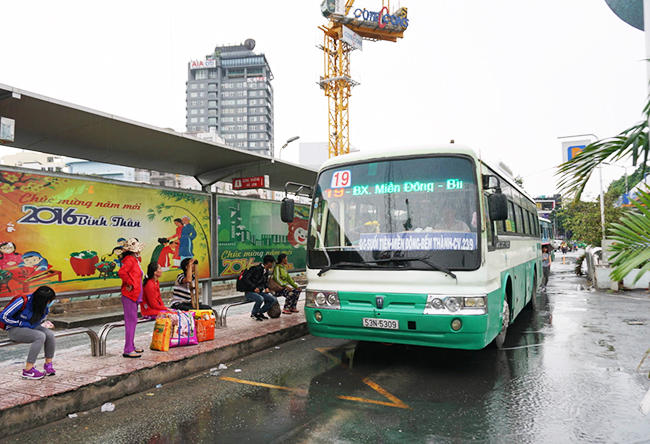
Bus No. 19 – Ho Chi Minh City
2. Interprovincial Bus
These modern buses are bigger and more comfortable than public buses, not to mention the fact that they are never crowded as tickets are sold by seat. Often called ‘Bus Deluxe’, these giants are much more spacious and some even have reclining seats or ach beds. Onboard, it is forbidden to smoke and you will enjoy the air conditioning as well as other amenities. Those are WiFi, screens, toilets and steward service.
These buses are offered from the main bus stations in the main cities of the country and will allow you to reach all the major cities and popular tourist destinations of Vietnam.

Inside a modern interprovincial bus in Vietnam
Interprovincial buses are much faster than local buses since they stop very little to pick up passengers, but note that they will stop in every major city you cross. By this way, you can have time to take a break, admire the city you visit and enjoy some specialties there.
The price depends on the distance of the route and the type of seats chosen. Various reputable and private bus companies offer journeys through Vietnam: Hoang Long, The Sinh Tourist, and Mai Linh Express.
If you are traveling from minor provinces and there is no direct route to your intended destinations, it is advisable to take a bus straight to major cities where those destinations are settled such as Hanoi, Hue or Da Nang and Ho Chi Minh City.
3. ‘Open’ Bus
If you want to travel a long distance by bus in Vietnam, you may consider to reserve a seat in an open tourist bus. Do not be fooled by the name. If we say the bus is ‘open’, it is because to travel on these buses, you will have to buy an open ticket which will allow you to get on or off the bus at various places along the way.
The buses are comfortable and extremely cheap. Even though, you had better keep in mind that despite these buses’ good price/ quality ratio, you must still be careful when you book your ticket. Because the more you get off and on the bus, the more expensive your ticket will be. Buses usually leave from central locations (often hostels frequented by travelers), so you do not have to make it to the bus station. Some buses with open circuit also stop along the road.
- The most popular bus stops open: Hanoi; Ho Chi Minh City; Ninh Binh; Phong Nha; Hue; Da Nang; Nha Trang; Da Lat; Mui Ne.
- Popular open bus companies: The Sinh Tourist (most recommended); Hanh cafe; Queen cafe; Tam Hanh, Hung Thanh Bus Travel Company.
4. Two-stage Bus
Since May 30th, 2018, three double-decker buses in Hanoi are in service of the city tour. Passengers can enjoy the cityscape and visit 30 sights in 25 streets around the capital. This experience is exciting and helps attract many new travelers to Vietnam.
There are 14 stopping places to accommodate passengers on the routes: Opera House, Hanoi Post Office, Dong Kinh Nghia Thuc Square, St. Joseph Cathedral, Ho Chi Minh Mausoleum.
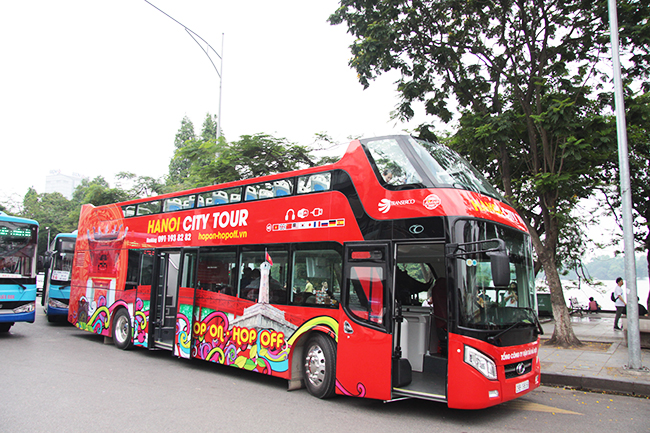
A two-stage bus waiting to pick up passengers at Hoan Kiem Lake, Hanoi
The current prices for bus tickets are 300, 000 VND / 4 hours, 450, 000 VND / 24 hours and 600, 000 VND / 48 hours. The bus line runs from 9:00 to 17:00 and leaves every 30 minutes. Tourists can stay at any tourist location if they wish, then they can actively take the next open-top bus to continue the tourist route as long as their tickets are still valid.
The Hanoi open-top buses offer customers popular routes including tourist sites typical of history and culture told through the attractive multi-lingual system on each bus. With this itinerary, tourists can save time by sorting out the best attractions to see Hanoi and find a way to get there.
Some Important Bus Routes:
- Weekdays Route:
Dong Kinh Nghia Thuc Square – Thai At – Trang Thi – Dien Bien Phu – Doc Lap – Hoang Van Thu – Hung Vuong – Thanh Nien – Yen Phu – Thanh Nien – Hung Vuong – Phan Dinh Phung God – Hong Phong – Hung Vuong – Nguyen Thai Hoc – The Temple of Literature – Ton Duc Thang – Nguyen Thai Hoc – Cua Nam – Phan Boi Chau – Ly Thuong Kiet – Phan Chu Trinh – Le Thanh Tong – Trang Tien – Dinh Tien Hoang – Parking Hoan Kiem Lake.
- Weekend Route (When the streets around Hoan Kiem Lake are for pedestrians only):
Hanoi Opera – Trang Tien – Nguyen Thai Hoc – Temple of Literature – Ton Duc Thang – Nguyen Thai Hoc – Cua Nam Phan Boi Chau – Ly Thuong Kiet – Le Thanh Tong – Hanoi Opera House.
Above all, a city tour in Hanoi with the “Hop on – Hop off” bus is a type of flexible travel that should not be missed, which promises you exciting experiences in Vietnam!
5. Sleeper Bus/ Night Bus
Night buses are more comfortable than others because they are composed of three rows of ‘bunk beds’. Although these beds are not completely flat, the backs are angled at a fixed angle. You will have enough space to extend your legs (unless you are a very tall person). Travelers who have opted for this means of transportation confirm that night buses are more comfortable than deluxe buses since you can expand; which is normally impossible in normal buses.
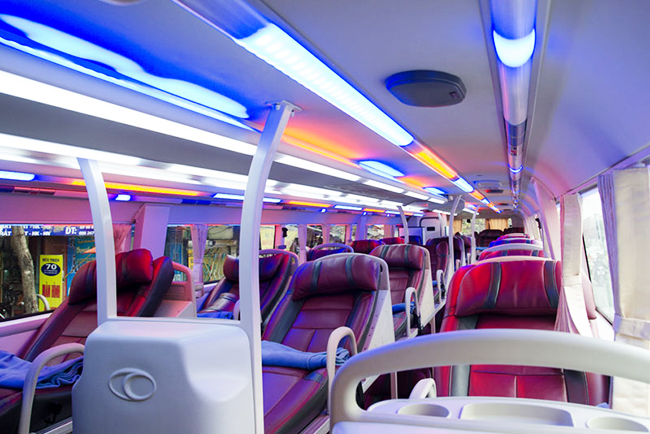
A typical sleeper bus in Vietnam
Be aware that traveling by night bus is relatively affordable. The price of a ticket is comparable to that of a second class seat on a train. The most considerable advantage with this service is that you will have a bed. While the seats on these buses are not as comfortable as the train bed, you’ll save a lot of money by choosing this option, since you will not have to pay for a hotel room at night.
How to Book Bus Tickets in Vietnam?
The place where you will buy your bus tickets to travel among Vietnam will depend mainly on the type of bus that you prefer. There are 4 ways to book bus tickets in Vietnam:
1. Onboard the bus
For local buses only.
2. In the bus station
Each region or city has several bus stations. Each of them offers a ticket sales service with different ticket offices where you can search for the prices and departure times of the route you choose. Here are the 4 important bus stations in Vietnam:
In Hanoi
- My Dinh Bus Station: The largest bus station in Hanoi with a large number of daily buses to different regions. To the northwest of Hanoi, there are Yen Bai, Phu Tho, Da Chong, Lao Cai, Ha Giang, Lang Son, Dien Bien, Halong Bay, Hoa Binh & Ninh Binh. Address: 20 Pham Hung Street, My Dinh, Hanoi.
- Giap Bat Bus Station: If the central and southern provinces are your goal, this resort is a perfect choice. Many buses serve Haiphong Province, Nam Dinh Province, Nghe An Province, Ninh Binh Province, and Ho Chi Minh City. Address: 06 Giai Phong Street, Ha Noi.
In Ho Chi Minh City
- Mien Dong Bus Station: Located 7 km from the city center, this bus station is the busiest in Ho Chi Minh City. If you want to visit Vung Tau, Phan Thiet-Mui Ne, Dalat, Nha Trang, Daklak or Hanoi; you can buy tickets at the terminals of the bus stations. Here, there are some bus companies operating including Minh Dung Bus, Hoang Long Bus, and Phuong Trang Bus. Address: 292 Dinh Bo Linh Street, Binh Thach District, HCMC.
- Mien Tay Bus Station: This station serves passengers wishing to travel to the Mekong Delta provinces, ranging from Tien Giang, Ben Tre to Ca Mau. Address: 395 Kinh Duong Vuong Street, Tan Binh District, HCMC.
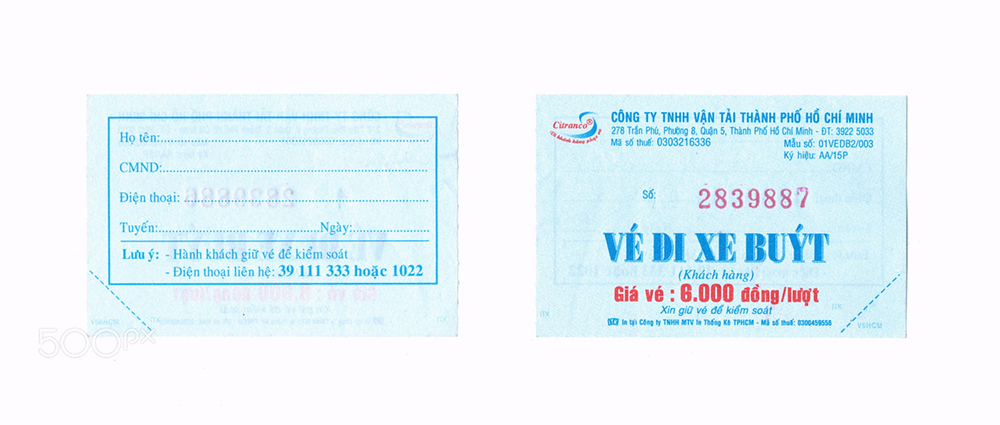
Two sides of a bus ticket in Ho Chi Minh City
3. Online
There are several websites that will allow you to book your own Vietnam bus tickets. You can access these three most popular websites: Ve Xe Re (for Vietnamese destinations) and 12Go, Baolau (for Asian destinations).
Tips for booking online:
- Search carefully for available bus routes to the destination you want to visit
Some destinations do not have a (big) bus station. As a result, you need to go to a big city close to this one and take a local bus. E.g: If you want to travel to Dong Hoi from Hoi An, you often have to take the bus to Da Nang or Phong Nha, then transfer to Dong Hoi.
- Check the correct name of the destination
If you can not find the destination’s availability on a website, check another site. It is possible that each website may indicate the availability of different bus companies.
- Tourists can ask their travel agencies to purchase a ticket in advance
When you book your bus ticket to Vietnam, you can choose the seat of your choice. However, the seats in the center of the bus are the most comfortable. On the other hand, there will be many other sites available but most of them are resellers and charge a lot more.
Instead, you can choose your travel agency to book a bus ticket in advance for you. On your Vietnam daily tour, it would be our pleasure to organize every step from A to Z to make sure you have the best experiences in our beautiful country.
So what are you waiting for? Customize your Vietnam tour now so that we can help with your trip to Vietnam!
Tips for Travelling by Bus in Vietnam
- Only buy bus tickets from the registered cabins of large companies inside the terminals. Some prestigious names to mention are Hoang Long, Viet Thanh, Sinh Coffee, Hanh Coffee, and Mai Linh.
- Ask for the price before you start otherwise you may be overloaded.
- Keep an eye on your things at the bus stations. Never leave them unattended, especially if you use a public and local bus.
- Download a language translation application to your phone to communicate more easily with Vietnamese staff and bus drivers.
- Do not hesitate to ask the driver, the bus staff or even your other passengers if there is something wrong with you. The Vietnamese are very friendly; they will be more than willing to help you.
- Some buses will stop for meals along the way. Therefore, if you can not eat local food, take a little bit food with you.
- Make sure you carry enough money or a credit card in case of emergency.
- If you take an overnight bus, prepare an eye mask and earplugs to help you sleep better.

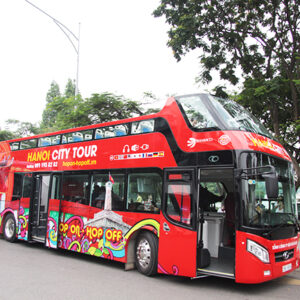







who are the dominant owners of these bus lines, locals or foreigners? am curious since here in the Philippines, it’s predominantly local and it’s everything but amazing.
I once experienced an amazing trip around Hanoi by two stage bus for sightseeing, and it was totally worth it! Pls write some more articles about transportation in Vietnam because i plan to travel across all land of Vietnam !
Thank you for your comment.
It is great to hear that you had such a wonderful experience of sightseeing our capital city by two-stage bus. And yes, I will definitely provide to my readers with more useful and updated information about travelling to and in Vietnam so please stay tuned!